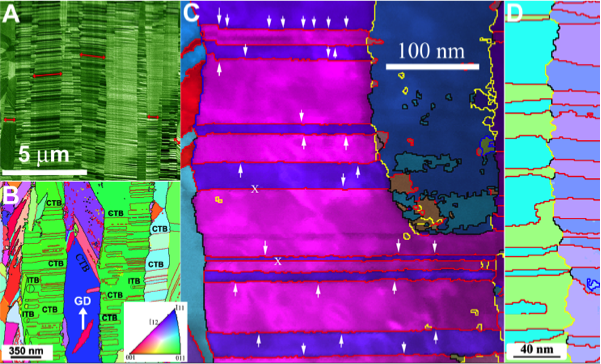LLNL BES Program Highlight
Scientific Achievement
We have identified topological features of nano-twinned microstructures that influence their thermal stability and mechanical behavior.
Significance and Impact
Understanding evolution of microstructural features under various stimuli is integral for designing materials to withstand the extreme environments of next-generation nuclear reactors.

(A) As-grown nanotwin copper SEM image. (B) An edge-on inverse pole figure orientation mapping (IPFOM) image; the coherent and incoherent twin boundaries are labeled as CTB and ITB (inside circles), respectively. (C) A high-resolution IPFOM image of CTBs. Some ITB segments are marked with white arrows. (D) An IPFOM image of along columnar grain boundary showing numerous ITB segments at the triple lines. yellow, low angle GBs with misorientation < 15° black, large angle GBs; red, Σ3 CSL boundary; blue, Σ9 CSL boundary.
T. LaGrange, B. W. Reed, M. Wall, J. Mason, T. Barbee, and M. Kumar, Topological view of the thermal stability of nanotwinned copper, Appl. Phys. Lett. 102, 011905 (2013)
Y. M. Wang, F. Sansoz, T. LaGrange, R. T. Ott, J. Marian, T. W. Barbee Jr and A. V. Hamza, Defective twin boundaries in nanotwinned metals, Nat. Mater., online 19 May (2013)
Research Details
- Using high-resolution orientation mapping, we analyzed the crystallography of grain boundary networks in nt-Cu films and have proven that the unstable nature of the constituent triple junctions governs their thermal and mechanical stability.
- Detwinning via mobile incoherent twin segments followed by lateral motion of the high-angle columnar boundaries negates the pinning effect of the triple junctions, unlike the case in conventional microstructures.
Research Summary
To understand aspects of microstructures that influence their evolution at high temperatures, we have examined topological features, such as grain boundary character distributions and grain boundary networks (GBN), and correlated these aspects to thermal coarsening and mechanical deformation behavior. We chose nanotwinned Copper (nt-Cu), which has a unique microstructure, exhibiting strong {111} fiber textures and a GBN consisting of high-angle or low-angle columnar boundaries interspersed with a high fraction of coincidence site lattice (CSL) boundaries. Using the NanoMEGAS ASTAR system, we have statistically analyzed the GBN in as-deposited and annealed nt-Cu foils and derived that the character of the columnar grain boundaries, triple junction structure and crystallographic structure of the nanotwins control their thermal stability and deformation characteristics. From observing the GBN evolution during thermal annealing, we infer that detwinning via mobile incoherent twin segments followed by lateral motion of the high-angle columnar boundaries negates the pinning effect of the triple junctions, promoting coarsening via thermal or mechanical activation.

Mukul Kumar
Principal Investigator for Mesoscale Simulations of Coarsening in GB Networks
kumar3 [at] llnl.gov (kumar3[at]llnl[dot]gov)




